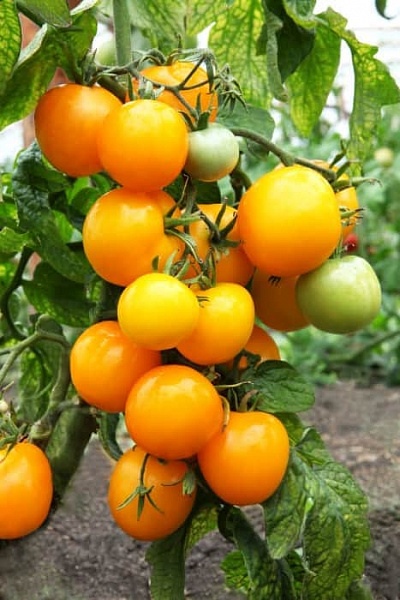
- Category: hybrid
- Growth type: determinant
- Appointment: universal
- Ripening period: early
- Ripening time, days: 110-115
- Growing conditions: for open ground, for film greenhouses
- Bush size: undersized
- Bush height, cm: 40
- Ripe fruit color: amber yellow
- Fruit shape: rounded
Many summer residents, gardeners and gardeners cannot imagine their own garden without tomatoes. Truly, this is the king of vegetables on Russian sites. For his sake, they buy and install expensive polycarbonate greenhouses, spend money on all kinds of grow boxes, phytolamps, hotbeds and greenhouses. Experienced gardeners have collections of their own seeds, time-tested, constantly replenish them with new products, including hybrids. One of these favorites is the determinant universal hybrid Apricot, intended for greenhouses and open ground. Tomato fruits are consumed fresh, used for whole-fruit canning, cooking sauces and lecho. Sweet, almost sugar little tomatoes are very fond of children.
Breeding history
The tomato is the result of the work of Riga breeders and is included in the State Register of Breeding Achievements.
Description of the variety
Low-growing (40 cm) bushes are covered with bright green, with a slight grayish tint, medium-sized foliage. Unfortunately, such a small growth does not protect weak shoots from lodging from the weight of ripening fruits. It is most correct to arrange supports, despite the low height.
The main qualities of the fruit
Small, even, rounded fruits weighing 60 grams are colored green, while immature, at the stage of technical ripeness they take on a beautiful lemon-yellow color. The fruits are very decorative both fresh and pickled.
Taste characteristics
The juicy sweet pulp of Apricot has a dense structure, the fruits contain an increased amount of niacin and lycopene. The first strengthens the walls of blood vessels, the second is a natural antioxidant. Yellow fruits can be eaten by people who are allergic to red vegetables and fruits. The dense skin allows long-term storage and transportation.
Ripening and fruiting
The variety is distinguished by extended periods of fruiting and early ripening of fruits (110-115 days). The harvest begins in June and continues in July, sometimes capturing August.
Yield
Apricot has good yield indicators: up to 3-5 kg are harvested from one bush, up to 18 kg from a square meter.
The timing of planting seedlings and planting in the ground
For sowing seeds for seedlings, the optimal time is chosen: March 15-20. You can plant young plants in a greenhouse already on April 5, and seedlings are transplanted into open ground in mid or late May.

Growing tomato seedlings is an extremely important process, because it largely depends on whether the gardener will be able to harvest at all. All aspects must be taken into account, from seedbed preparation to planting in the ground.
Landing scheme
During the transfer of plants from boxes to a permanent place, the most suitable distance between the roots is observed - 40x40 cm.

Growing and care
The optimal format for growing a hybrid Apricot is a seedling method and greenhouse conditions. In the open field, tomato is grown in warm regions with a large amount of SAT (the sum of active temperatures), in other regions it needs protection. The process is fully consistent with classical methods, and is grown in seedlings.
Before sowing, the seeds are treated with stimulant drugs.
Sowing is carried out in peat tablets, glasses or seedling boxes.
At first, weak shoots grow in a greenhouse - under glass or film.
For mature seedlings, it is necessary to harden before planting in a permanent place.
Growing of adult tomatoes takes place in sunny, fertile, breathable soil with a neutral pH level. The prepared holes are enriched with organic matter, mineral fertilizers, wood ash. Supports for future bushes are immediately installed in the pits. The planted plants are well spilled with warm water, after which it remains to observe traditional agronomic techniques.
Watering.
Weeding.
Loosening.
Top dressing.
Stealing.
Formation into 1-2 stems.
Thinning of dense foliage to ensure free air access to the fruit, as well as to avoid late blight.
Often, loosening is replaced by mulching. Ventilation is required in greenhouses. Top dressing is carried out at least three times per season. During the flowering period, nitrogen fertilizers are used; in the budding stage, the plant needs potassium-phosphorus substances. For tomatoes, formulations such as mullein and nettle infusion are suitable.




A plant needs different micronutrients at each stage of growth. All fertilizers can be divided into two groups: mineral and organic. Folk remedies are often used: iodine, yeast, bird droppings, eggshells.
It is important to observe the rate and period of feeding. This also applies to folk remedies and organic fertilizers.
Disease and pest resistance
One of the advantages of Apricot is resistance to all major types of nightshade diseases, but strong immunity is not a panacea. Whiteflies, aphids, slugs are dangerous in greenhouses; spider mites live in open spaces. Even with good health, high humidity in the greenhouse can provoke late blight. In order to avoid such problems, it is necessary to periodically treat plants with insecticides and fungicides.


Resistant to adverse weather conditions
The tomato does not have particular endurance, but it tolerates temperature extremes well.
Growing regions
The tomato is adapted for cultivation in greenhouses in the middle zone, it is possible to grow in open ground in the southern regions. For more northern regions, cultivation even in greenhouses is possible only with additional heating.

























































































